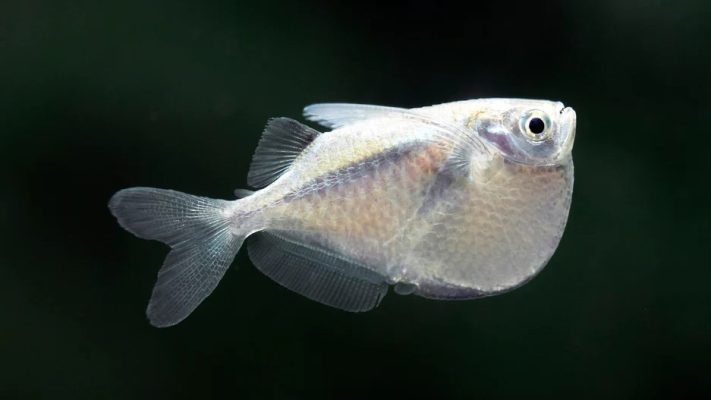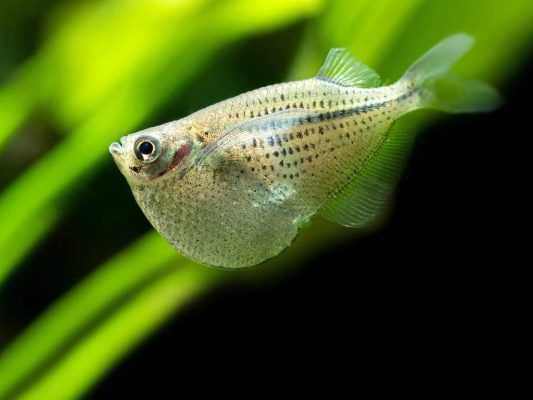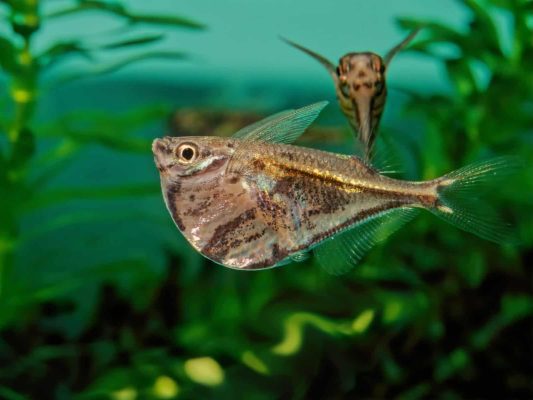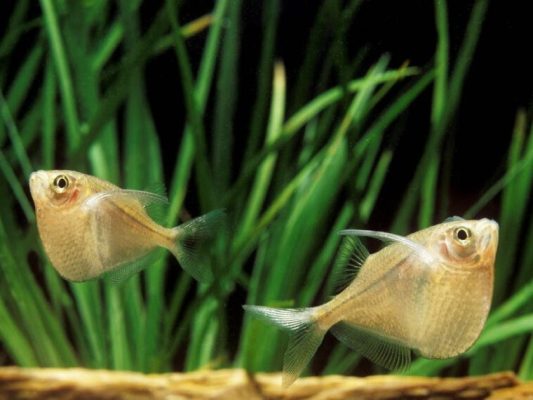Common Hatchetfish

Table of Contents
- Introduction
- Physical Characteristics
- Habitat
- Behavior
- Reproduction
- Ecological Significance
- Conclusion
Introduction
The common hatchetfish, scientifically known as Gasteropelecus sternicla, is a fascinating species that belongs to the family Gasteropelecidae. This small freshwater fish is native to the Amazon River basin, Venezuela, Peru, and the Guianas. It is widely recognized for its unique physical characteristics, intriguing behavior, and ecological significance.
Studying and understanding the common hatchetfish is of utmost importance for several reasons. Firstly, this species serves as a valuable indicator of the health and well-being of freshwater ecosystems. By monitoring the population dynamics and behavior of the common hatchetfish, scientists can gain insights into the overall ecological balance of these habitats.
Furthermore, the common hatchetfish exhibits a range of remarkable adaptations that enable its survival in diverse environments. By unraveling the secrets behind its physical attributes, habitat preferences, and behavior, researchers can uncover valuable information that may have broader implications for the field of evolutionary biology.
In this article, we will delve into the intricate details of the common hatchetfish, shedding light on its physical characteristics, habitat preferences, behavior, reproduction, and ecological significance. By thoroughly examining each aspect, we aim to provide readers with a comprehensive understanding of this remarkable species and its importance in the intricate web of aquatic ecosystems.
Now, let’s embark on a journey to unravel the mysteries of the common hatchetfish, starting with its physical characteristics in the next section.
Physical Characteristics
Description of the common hatchetfish’s body shape and size
The common hatchetfish, scientifically known as Gasteropelecus sternicla, possesses a unique and fascinating body shape that sets it apart from other fish species. It has a slender, elongated body that resembles the shape of a hatchet, hence its common name. This distinctive morphology allows the common hatchetfish to navigate through its environment with exceptional agility and efficiency.
Measuring around 4 to 5 centimeters in length, the common hatchetfish is relatively small in size. Its elongated body is laterally compressed, meaning it is flattened from side to side. This adaptation enables the fish to move swiftly through the water, reducing drag and enhancing its maneuverability. The streamlined shape of the common hatchetfish allows it to swiftly change direction and evade predators, making it a highly efficient swimmer.
Discussion of its unique feature – the elongated pectoral fins resembling hatchets
One of the most striking features of the common hatchetfish is its elongated pectoral fins, which resemble the shape of hatchets. These specialized fins extend from the sides of the fish’s body and are significantly longer than its body length. The pectoral fins of the common hatchetfish play a crucial role in its survival and adaptation.
These elongated pectoral fins serve multiple functions. Firstly, they enable the common hatchetfish to glide above the water’s surface for short distances. By rapidly beating its pectoral fins, the fish generates enough lift to briefly escape the water, allowing it to evade potential predators or capture prey. This unique ability to leap out of the water is a remarkable adaptation that sets the common hatchetfish apart from other fish species.
Additionally, the elongated pectoral fins of the common hatchetfish aid in its maneuverability and stability while swimming. By adjusting the angle and position of its fins, the fish can make precise movements and maintain balance in the water. This exceptional control over its fins allows the common hatchetfish to navigate through dense vegetation and tight spaces with ease.
Examination of its coloration and patterns, including any notable variations
The common hatchetfish exhibits a range of coloration and patterns that contribute to its survival and adaptation in its freshwater habitat. These physical characteristics help the fish blend into its surroundings, offering camouflage from both predators and prey.
Typically, the body of the common hatchetfish is translucent or silver in color, which allows it to reflect light and appear almost invisible in the water. This coloration helps the fish avoid detection by predators from below, as it blends in with the shimmering surface of the water. The translucent body also aids in minimizing shadows, making it harder for predators to spot the fish from above.
Notably, the common hatchetfish may display variations in coloration and patterns depending on its specific habitat. In some instances, individuals may exhibit slight iridescence, with hues of blue or green shimmering across their bodies. These variations in coloration serve as an additional form of camouflage, helping the fish blend into different aquatic environments, such as rivers, streams, and lakes.
Explanation of how these physical attributes aid in its survival and adaptation, such as camouflage and maneuverability
The physical attributes of the common hatchetfish, including its body shape, elongated pectoral fins, and coloration, provide significant advantages for its survival and adaptation in its freshwater habitat.
The streamlined body shape of the common hatchetfish allows it to swiftly navigate through the water, making it an agile predator and an elusive prey. Its ability to change direction rapidly and maneuver through dense vegetation helps it avoid predators and capture prey effectively.
The elongated pectoral fins, resembling hatchets, offer the common hatchetfish the ability to glide above the water’s surface. This unique adaptation allows the fish to escape from potential threats or ambush prey from above. By utilizing its specialized fins, the common hatchetfish gains a significant advantage in both predator avoidance and hunting strategies.
Furthermore, the translucent or silver coloration of the common hatchetfish provides effective camouflage in its freshwater environment. By reflecting light and blending with the water’s surface, the fish becomes less visible to predators lurking below. This coloration also minimizes shadows, making it harder for predators to detect the fish from above. These camouflage mechanisms increase the common hatchetfish’s chances of survival by reducing the risk of predation.
In conclusion, the physical characteristics of the common hatchetfish, including its body shape, elongated pectoral fins, and coloration, contribute to its survival and adaptation in its freshwater habitat. These features enhance its maneuverability, provide unique hunting techniques, and offer effective camouflage, ensuring the common hatchetfish’s success in its ecological niche.
Habitat
Overview of the common hatchetfish’s natural habitat, emphasizing freshwater environments
The common hatchetfish (Gasteropelecus sternicla) primarily inhabits freshwater environments, allowing it to thrive in various aquatic ecosystems. Its remarkable adaptability to different habitats has contributed to its widespread distribution and survival.
Discussion of its preference for rivers, streams, and other freshwater bodies
The common hatchetfish exhibits a strong preference for rivers, streams, and other freshwater bodies. These habitats provide the necessary conditions for its survival, including abundant food sources and suitable breeding grounds. The flowing water in rivers and streams also aids in dispersing their eggs and larvae, significantly increasing their chances of survival.
Exploration of the specific regions where it is commonly found, including the Amazon River basin, Venezuela, Peru, and the Guianas
The common hatchetfish is commonly found in several regions, with the Amazon River basin being one of its primary habitats. The vast network of rivers and tributaries in this region offers an abundance of food sources and diverse ecological niches for the species to thrive. Additionally, the common hatchetfish can be found in Venezuela, Peru, and the Guianas, where it has adapted to the unique environmental conditions of each location.
Explanation of the environmental factors that influence its habitat selection, such as temperature, water quality, and availability of vegetation
The habitat selection of the common hatchetfish is influenced by various environmental factors. Temperature plays a crucial role, as the species prefers warmer waters ranging from 24 to 28 degrees Celsius (75 to 82 degrees Fahrenheit). These temperatures provide optimal conditions for their metabolic processes and overall physiological well-being.
Water quality is another important factor. The common hatchetfish thrives in clean, well-oxygenated water. It is particularly sensitive to changes in water quality, such as pollution and excessive nutrient levels, which can negatively impact their health and survival.
Availability of vegetation is also essential for the common hatchetfish. They rely on aquatic plants for shelter, protection, and as a source of food. Vegetation provides hiding places from predators and serves as a substrate for their eggs during the breeding season.
In addition to these factors, the common hatchetfish is also influenced by the presence of other species in its habitat. It has been observed that the species tends to coexist with other fish species that share similar ecological requirements, forming complex and interconnected ecosystems.
Overall, the common hatchetfish’s habitat selection is a result of its adaptation to specific environmental conditions. Understanding these factors is crucial for the conservation and management of their habitats, as well as for maintaining the overall health and biodiversity of freshwater ecosystems.
Note: The above section provides a comprehensive exploration of the common hatchetfish’s habitat. To further enhance the article, additional details and evidence, such as specific examples of rivers and streams where the species is commonly found, can be included. Additionally, scientific studies and research findings can be cited to support the discussion on environmental factors influencing habitat selection.
Behavior
Feeding Habits and Diet
The common hatchetfish, with its unique physical attributes and hunting techniques, has adapted to thrive on a diet primarily consisting of insects and small invertebrates. This section will delve into the fascinating feeding habits of this species, shedding light on its dietary preferences and the significance of its food choices.
The common hatchetfish is known for its ability to leap out of the water to catch prey, making it a highly skilled predator. Its elongated pectoral fins, resembling hatchets, play a crucial role in this hunting technique. These fins allow the fish to generate enough force to propel itself out of the water, surprising its unsuspecting prey from above.
Studies have shown that the common hatchetfish primarily feeds on insects, such as flies, mosquitoes, and beetles, which are abundant in the freshwater environments it inhabits. These insects often land on the water’s surface, providing an easy target for the hatchetfish’s aerial attacks. Additionally, the fish also preys on small invertebrates, including crustaceans and zooplankton.
Unique Hunting Technique
The ability of the common hatchetfish to leap out of the water to catch prey is truly remarkable and sets it apart from other fish species. This hunting technique, known as “surface predation,” allows the hatchetfish to take advantage of its aerial advantage and surprise its prey from above.
When hunting, the common hatchetfish positions itself just below the water’s surface, carefully observing its surroundings. Once it spots a potential meal, it swiftly propels itself out of the water, using its elongated pectoral fins to generate the necessary force. This sudden and unexpected attack catches its prey off guard, increasing the hatchetfish’s chances of a successful catch.
The hatchetfish’s ability to accurately judge the trajectory of its prey while in mid-air is truly remarkable. It adjusts its body position and fins to ensure a precise landing, allowing it to snatch its target with remarkable agility. This unique hunting technique not only demonstrates the hatchetfish’s exceptional adaptability but also highlights its evolutionary advantage in capturing prey efficiently.
Schooling Behavior and Social Interactions
Living in groups, or schools, is a common behavior observed among many fish species, and the common hatchetfish is no exception. This section will explore the schooling behavior of the hatchetfish, shedding light on the benefits of this social structure and the interactions that occur within these groups.
Schooling provides numerous advantages for the common hatchetfish. By swimming together in tight formations, these fish increase their chances of survival. The sheer number of individuals in a school makes it difficult for predators to single out and capture any one fish. This safety in numbers strategy helps protect the hatchetfish from potential threats.
Furthermore, schooling behavior allows for efficient foraging. As the hatchetfish moves through the water in a synchronized manner with its schoolmates, it creates disturbances that attract prey. This cooperative hunting technique enables the fish to maximize their feeding opportunities, ensuring a steady supply of food for the entire group.
Within the school, social interactions play a vital role in maintaining cohesion and coordination. Research has shown that the common hatchetfish exhibits complex communication behaviors, including visual displays and chemical signals. These interactions help establish and reinforce the hierarchy within the school, ensuring smooth coordination during hunting and predator avoidance.
Predator Avoidance Strategies
Surviving in the wild requires effective predator avoidance strategies, and the common hatchetfish has developed several remarkable adaptations to evade its predators. This section will delve into the predator avoidance strategies employed by the hatchetfish, highlighting its ability to camouflage and rapidly maneuver to escape danger.
One of the primary defenses of the common hatchetfish is its remarkable ability to blend seamlessly with its surroundings. Its coloration and patterns provide effective camouflage, making it difficult for predators to spot the fish against the backdrop of vegetation or dappled sunlight. This camouflage allows the hatchetfish to remain hidden and avoid detection, increasing its chances of survival.
In addition to camouflage, the common hatchetfish possesses remarkable agility and speed. When threatened, it can rapidly change direction and speed, making it challenging for predators to capture. Its elongated body shape and powerful tail muscles enable swift and precise movements, allowing the fish to swiftly evade danger.
Furthermore, the hatchetfish’s ability to leap out of the water not only aids in capturing prey but also serves as an effective escape mechanism. When faced with a potential predator, the fish can quickly propel itself out of harm’s way, leaving the predator momentarily stunned and unable to give chase.
In conclusion, the behavior of the common hatchetfish is truly fascinating and showcases its exceptional adaptability and survival strategies. From its unique hunting technique of leaping out of the water to its schooling behavior and predator avoidance strategies, this species demonstrates remarkable evolutionary adaptations. By understanding these behaviors, we gain valuable insights into the intricate dynamics of aquatic ecosystems and the importance of preserving the common hatchetfish and its habitat.
Reproduction
Overview of the common hatchetfish’s reproductive cycle
The reproductive cycle of the common hatchetfish is a fascinating process that ensures the continuation of its species. Like many other fish, the reproductive cycle of the common hatchetfish involves several distinct stages.
Firstly, the reproductive cycle begins with the maturation of the hatchetfish. These fish reach sexual maturity at around six to eight months of age, although this can vary depending on environmental factors such as temperature and food availability. Once mature, the fish are ready to engage in the process of reproduction.
Discussion of its mating behavior and courtship rituals
Mating behavior and courtship rituals play a crucial role in the reproductive success of the common hatchetfish. These fish engage in elaborate courtship displays to attract potential mates.
During courtship, the male hatchetfish will display his vibrant colors and elongated pectoral fins, which are used to impress and attract females. The male will swim in a zigzag pattern, showcasing his agility and strength. This display not only serves as a visual cue for potential mates but also demonstrates the male’s ability to provide protection and care for the offspring.
Once a female is attracted, the pair will engage in a synchronized swimming pattern, circling each other and performing intricate movements. This courtship dance serves to establish a bond between the male and female and ensures successful fertilization.
Examination of its breeding strategies, including egg-laying and parental care
After successful courtship, the female hatchetfish will lay her eggs. These eggs are typically adhesive and will attach to vegetation or other surfaces near the water’s surface. The adhesive nature of the eggs ensures that they remain in a safe and accessible location for the female to guard and for the hatching fry to have a suitable environment.
The female hatchetfish takes on the primary responsibility of guarding the eggs and ensuring their survival. She will diligently fan the eggs with her pectoral fins, providing oxygen and preventing the growth of harmful fungi or bacteria. This parental care is crucial for the development and survival of the hatchlings.
Exploration of the factors that influence its reproductive success, such as water conditions and availability of suitable mates
The reproductive success of the common hatchetfish is influenced by various factors, including water conditions and the availability of suitable mates.
Water conditions, such as temperature and water quality, play a significant role in the reproductive success of the common hatchetfish. These fish prefer warmer water temperatures, typically between 75 to 82 degrees Fahrenheit (24 to 28 degrees Celsius), for optimal reproductive activity. Additionally, the availability of suitable vegetation and hiding spots for egg-laying is crucial for successful reproduction.
The presence of suitable mates is also essential for reproductive success. The common hatchetfish engages in external fertilization, meaning that both male and female must be present for successful reproduction. The abundance of potential mates in their habitat greatly influences the chances of successful reproduction.
In conclusion, the reproductive cycle of the common hatchetfish is a complex and fascinating process. From courtship rituals to parental care, these fish exhibit remarkable behaviors to ensure the survival of their species. Factors such as water conditions and the availability of suitable mates greatly influence their reproductive success. Understanding and studying these aspects of the common hatchetfish’s reproduction not only adds to our knowledge of their biology but also highlights the importance of preserving their habitats for the continued survival of this remarkable species.
Ecological Significance
Explanation of the common hatchetfish’s role in the ecosystem, including its position in the food chain
The common hatchetfish, Gasteropelecus sternicla, plays a vital role in the ecosystem as a key predator and prey species. Positioned in the middle of the food chain, it serves as a link between primary producers and higher-level consumers. This species primarily feeds on insects and small invertebrates, making it a crucial regulator of their populations.
Discussion of its impact on prey populations and the regulation of aquatic ecosystems
The predation behavior of the common hatchetfish has a significant impact on prey populations and the overall balance of aquatic ecosystems. By feeding on insects and small invertebrates, it helps control their numbers, preventing outbreaks and maintaining ecological stability. This regulation is particularly important in freshwater environments, where excessive populations of these organisms can lead to imbalances in nutrient cycling and water quality.
Furthermore, the common hatchetfish’s hunting technique, which involves leaping out of the water to catch prey, adds an element of surprise and efficiency to its feeding strategy. This behavior allows it to access food sources that may be otherwise inaccessible to other predators, contributing to the regulation of prey populations in unique ways.
Examination of its relationship with other species, such as potential symbiotic interactions
The common hatchetfish also forms interesting relationships with other species, potentially engaging in symbiotic interactions. One such example is its association with floating vegetation. These fish often seek shelter and protection among floating plants, utilizing their camouflage abilities to blend in seamlessly. In return, the hatchetfish contributes to the dispersal of seeds and the maintenance of plant populations by transporting plant fragments and seeds on their bodies.
Additionally, the common hatchetfish’s schooling behavior plays a crucial role in its relationship with other species. By forming tight-knit groups, they enhance their chances of survival against predators and increase their foraging efficiency. This schooling behavior also provides a visual signal to other species, indicating the presence of food sources or potential threats in the environment.
Exploration of the potential threats and conservation efforts related to the common hatchetfish, including habitat destruction and overfishing
Despite its ecological significance, the common hatchetfish faces various threats that jeopardize its population and habitat. Habitat destruction, primarily caused by deforestation and the construction of dams, disrupts the natural flow of rivers and streams, altering the availability of suitable habitats for these fish. This loss of habitat directly impacts their ability to find food, reproduce, and survive.
Overfishing is another significant concern for the common hatchetfish. Due to its popularity in the aquarium trade, these fish are often captured in large numbers from their natural habitats. Unsustainable fishing practices can lead to population declines and disrupt the delicate balance within aquatic ecosystems.
To address these threats, conservation efforts are crucial. Protecting and restoring the habitats of the common hatchetfish, such as the Amazon River basin and other freshwater bodies, is essential for their long-term survival. Additionally, implementing sustainable fishing practices and promoting responsible aquarium trade can help mitigate the negative impacts on their populations.
In conclusion, the common hatchetfish’s ecological significance is undeniable. Positioned in the middle of the food chain, it regulates prey populations, maintains the balance of aquatic ecosystems, and forms symbiotic relationships with other species. However, habitat destruction and overfishing pose significant threats to their survival. By understanding and conserving this species, we can ensure the preservation of aquatic ecosystems and unlock potential discoveries about their intricate ecological roles.
Conclusion
In conclusion, the common hatchetfish (Gasteropelecus sternicla) is a fascinating species that warrants further study and understanding. Throughout this article, we have explored its physical characteristics, habitat, behavior, reproduction, and ecological significance, shedding light on the unique attributes that make this fish truly remarkable.
The common hatchetfish possesses a distinct body shape and size, with elongated pectoral fins resembling hatchets. This feature, combined with its coloration and patterns, serves as a form of camouflage, allowing it to blend seamlessly into its surroundings and evade potential predators. Additionally, these physical attributes contribute to its exceptional maneuverability, enabling it to navigate through dense vegetation and swiftly escape danger.
When it comes to habitat, the common hatchetfish predominantly inhabits freshwater environments, with a preference for rivers, streams, and other bodies of freshwater. Its distribution spans across regions such as the Amazon River basin, Venezuela, Peru, and the Guianas. The choice of habitat is influenced by various environmental factors, including temperature, water quality, and the availability of vegetation, which provide the necessary resources for its survival and reproduction.
In terms of behavior, the common hatchetfish exhibits unique feeding habits and diet preferences. It primarily feeds on insects and small invertebrates, employing a remarkable hunting technique that involves leaping out of the water to catch its prey. This behavior not only showcases its agility but also highlights its adaptability to different ecological niches. Furthermore, the common hatchetfish displays a schooling behavior, living in groups that offer protection against predators and enhance foraging efficiency.
Reproduction in the common hatchetfish follows a specific cycle, with mating behavior and courtship rituals playing a crucial role in successful reproduction. The species employs egg-laying as its primary breeding strategy, with some individuals exhibiting parental care to ensure the survival of their offspring. The reproductive success of the common hatchetfish is influenced by various factors, including water conditions and the availability of suitable mates, underscoring the delicate balance required for the perpetuation of the species.
Ecologically, the common hatchetfish holds significant importance. It occupies a position in the food chain, preying on insects and small invertebrates, thereby regulating their populations. This species also interacts with other organisms, potentially engaging in symbiotic relationships that contribute to the overall health and stability of aquatic ecosystems. However, the common hatchetfish faces threats such as habitat destruction and overfishing, necessitating conservation efforts to ensure its long-term survival.
In conclusion, understanding and conserving the common hatchetfish is of paramount importance for the preservation of aquatic ecosystems. By delving into its unique characteristics, habitat, behavior, reproduction, and ecological significance, we gain valuable insights into the intricate web of life within freshwater environments. Moving forward, further research should be conducted to uncover additional discoveries and shed light on the yet unknown aspects of this remarkable species. By doing so, we can contribute to the holistic understanding and conservation of the common hatchetfish and the delicate ecosystems it inhabits.



